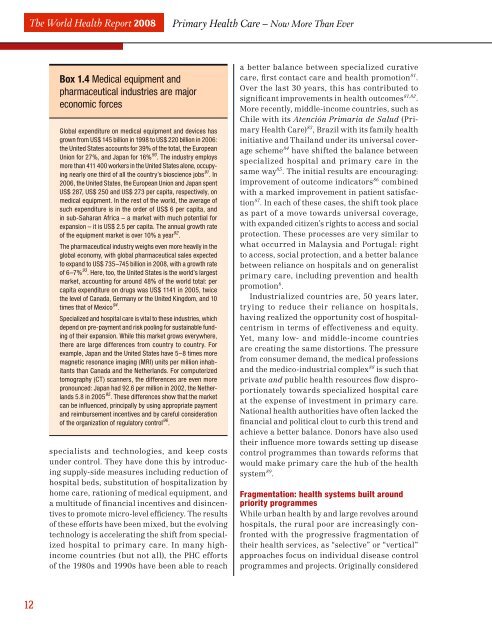Primary health care: now more than ever - World Health Organization
Primary health care: now more than ever - World Health Organization
Primary health care: now more than ever - World Health Organization
Create successful ePaper yourself
Turn your PDF publications into a flip-book with our unique Google optimized e-Paper software.
The <strong>World</strong> <strong>Health</strong> Report 2008<strong>Primary</strong> <strong>Health</strong> Care – Now More Than EverBox 1.4 Medical equipment andpharmaceutical industries are majoreconomic forcesGlobal expenditure on medical equipment and devices hasgrown from US$ 145 billion in 1998 to US$ 220 billion in 2006:the United States accounts for 39% of the total, the EuropeanUnion for 27%, and Japan for 16% 90 . The industry employs<strong>more</strong> <strong>than</strong> 411 400 workers in the United States alone, occupyingnearly one third of all the country’s bioscience jobs 91 . In2006, the United States, the European Union and Japan spentUS$ 287, US$ 250 and US$ 273 per capita, respectively, onmedical equipment. In the rest of the world, the average ofsuch expenditure is in the order of US$ 6 per capita, andin sub-Saharan Africa – a market with much potential forexpansion – it is US$ 2.5 per capita. The annual growth rateof the equipment market is over 10% a year 92 .The pharmaceutical industry weighs even <strong>more</strong> heavily in theglobal economy, with global pharmaceutical sales expectedto expand to US$ 735–745 billion in 2008, with a growth rateof 6–7% 93 . Here, too, the United States is the world’s largestmarket, accounting for around 48% of the world total: percapita expenditure on drugs was US$ 1141 in 2005, twicethe level of Canada, Germany or the United Kingdom, and 10times that of Mexico 94 .Specialized and hospital <strong>care</strong> is vital to these industries, whichdepend on pre-payment and risk pooling for sustainable fundingof their expansion. While this market grows <strong>ever</strong>ywhere,there are large differences from country to country. Forexample, Japan and the United States have 5–8 times <strong>more</strong>magnetic resonance imaging (MRI) units per million inhabitants<strong>than</strong> Canada and the Netherlands. For computerizedtomography (CT) scanners, the differences are even <strong>more</strong>pronounced: Japan had 92.6 per million in 2002, the Netherlands5.8 in 2005 95 . These differences show that the marketcan be infl uenced, principally by using appropriate paymentand reimbursement incentives and by <strong>care</strong>ful considerationof the organization of regulatory control 96 .specialists and technologies, and keep costsunder control. They have done this by introducingsupply-side measures including reduction ofhospital beds, substitution of hospitalization byhome <strong>care</strong>, rationing of medical equipment, anda multitude of financial incentives and disincentivesto promote micro-level efficiency. The resultsof these efforts have been mixed, but the evolvingtechnology is accelerating the shift from specializedhospital to primary <strong>care</strong>. In many highincomecountries (but not all), the PHC effortsof the 1980s and 1990s have been able to reacha better balance between specialized curative<strong>care</strong>, first contact <strong>care</strong> and <strong>health</strong> promotion 81 .Over the last 30 years, this has contributed tosignificant improvements in <strong>health</strong> outcomes 81,82 .More recently, middle-income countries, such asChile with its Atención Primaria de Salud (<strong>Primary</strong><strong>Health</strong> Care) 83 , Brazil with its family <strong>health</strong>initiative and Thailand under its universal coveragescheme 84 have shifted the balance betweenspecialized hospital and primary <strong>care</strong> in thesame way 85 . The initial results are encouraging:improvement of outcome indicators 86 combinedwith a marked improvement in patient satisfaction87 . In each of these cases, the shift took placeas part of a move towards universal coverage,with expanded citizen’s rights to access and socialprotection. These processes are very similar towhat occurred in Malaysia and Portugal: rightto access, social protection, and a better balancebetween reliance on hospitals and on generalistprimary <strong>care</strong>, including prevention and <strong>health</strong>promotion 6 .Industrialized countries are, 50 years later,trying to reduce their reliance on hospitals,having realized the opportunity cost of hospitalcentrismin terms of effectiveness and equity.Yet, many low- and middle-income countriesare creating the same distortions. The pressurefrom consumer demand, the medical professionsand the medico-industrial complex 88 is such thatprivate and public <strong>health</strong> resources flow disproportionatelytowards specialized hospital <strong>care</strong>at the expense of investment in primary <strong>care</strong>.National <strong>health</strong> authorities have often lacked thefinancial and political clout to curb this trend andachieve a better balance. Donors have also usedtheir influence <strong>more</strong> towards setting up diseasecontrol programmes <strong>than</strong> towards reforms thatwould make primary <strong>care</strong> the hub of the <strong>health</strong>system 89 .Fragmentation: <strong>health</strong> systems built aroundpriority programmesWhile urban <strong>health</strong> by and large revolves aroundhospitals, the rural poor are increasingly confrontedwith the progressive fragmentation oftheir <strong>health</strong> services, as “selective” or “vertical”approaches focus on individual disease controlprogrammes and projects. Originally considered12

















